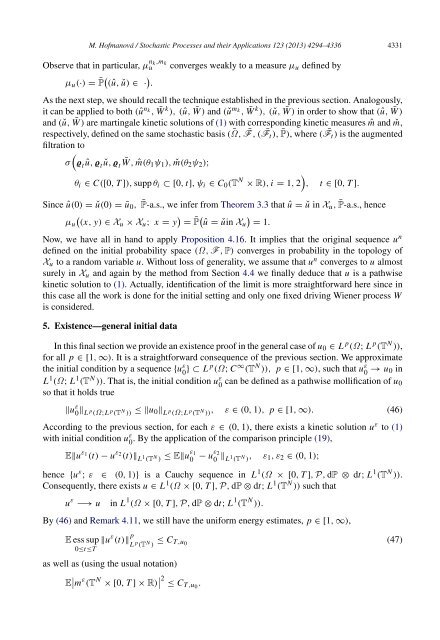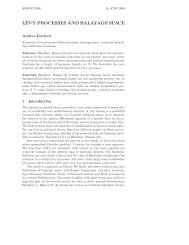Degenerate parabolic stochastic partial differential equations
Degenerate parabolic stochastic partial differential equations
Degenerate parabolic stochastic partial differential equations
You also want an ePaper? Increase the reach of your titles
YUMPU automatically turns print PDFs into web optimized ePapers that Google loves.
M. Hofmanová / Stochastic Processes and their Applications 123 (2013) 4294–4336 4331<br />
Observe that in particular, µ n k,m k<br />
u<br />
µ u (·) = ¯P (û, ǔ) ∈ ·.<br />
converges weakly to a measure µ u defined by<br />
As the next step, we should recall the technique established in the previous section. Analogously,<br />
it can be applied to both (û n k<br />
, ¯W k ), (û, ¯W ) and (ǔ m k<br />
, ¯W k ), (ǔ, ¯W ) in order to show that (û, ¯W )<br />
and (ǔ, ¯W ) are martingale kinetic solutions of (1) with corresponding kinetic measures ˆm and ˇm,<br />
respectively, defined on the same <strong>stochastic</strong> basis ( ¯Ω, F ¯ , ( F¯<br />
t ), ¯P), where ( F¯<br />
t ) is the augmented<br />
filtration to<br />
<br />
σ ϱ t û, ϱ t ǔ, ϱ t<br />
¯W , ˆm(θ 1 ψ 1 ), ˇm(θ 2 ψ 2 );<br />
<br />
θ i ∈ C([0, T ]), supp θ i ⊂ [0, t], ψ i ∈ C 0 (T N × R), i = 1, 2 , t ∈ [0, T ].<br />
Since û(0) = ǔ(0) = ū 0 , ¯P-a.s., we infer from Theorem 3.3 that û = ǔ in X u , ¯P-a.s., hence<br />
µ u<br />
<br />
(x, y) ∈ Xu × X u ; x = y = ¯P û = ǔin X u<br />
<br />
= 1.<br />
Now, we have all in hand to apply Proposition 4.16. It implies that the original sequence u n<br />
defined on the initial probability space (Ω, F , P) converges in probability in the topology of<br />
X u to a random variable u. Without loss of generality, we assume that u n converges to u almost<br />
surely in X u and again by the method from Section 4.4 we finally deduce that u is a pathwise<br />
kinetic solution to (1). Actually, identification of the limit is more straightforward here since in<br />
this case all the work is done for the initial setting and only one fixed driving Wiener process W<br />
is considered.<br />
5. Existence—general initial data<br />
In this final section we provide an existence proof in the general case of u 0 ∈ L p (Ω; L p (T N )),<br />
for all p ∈ [1, ∞). It is a straightforward consequence of the previous section. We approximate<br />
the initial condition by a sequence {u ε 0 } ⊂ L p (Ω; C ∞ (T N )), p ∈ [1, ∞), such that u ε 0 → u 0 in<br />
L 1 (Ω; L 1 (T N )). That is, the initial condition u ε 0 can be defined as a pathwise mollification of u 0<br />
so that it holds true<br />
∥u ε 0 ∥ L p (Ω;L p (T N )) ≤ ∥u 0∥ L p (Ω;L p (T N )), ε ∈ (0, 1), p ∈ [1, ∞). (46)<br />
According to the previous section, for each ε ∈ (0, 1), there exists a kinetic solution u ε to (1)<br />
with initial condition u ε 0<br />
. By the application of the comparison principle (19),<br />
E∥u ε 1<br />
(t) − u ε 2<br />
(t)∥ L 1 (T N ) ≤ E∥uε 1<br />
0 − uε 2<br />
0 ∥ L 1 (T N ) , ε 1, ε 2 ∈ (0, 1);<br />
hence {u ε ; ε ∈ (0, 1)} is a Cauchy sequence in L 1 (Ω × [0, T ], P, dP ⊗ dt; L 1 (T N )).<br />
Consequently, there exists u ∈ L 1 (Ω × [0, T ], P, dP ⊗ dt; L 1 (T N )) such that<br />
u ε −→ u in L 1 (Ω × [0, T ], P, dP ⊗ dt; L 1 (T N )).<br />
By (46) and Remark 4.11, we still have the uniform energy estimates, p ∈ [1, ∞),<br />
E ess sup ∥u ε (t)∥ p L<br />
0≤t≤T<br />
p (T N ) ≤ C T,u 0<br />
(47)<br />
as well as (using the usual notation)<br />
E m ε (T N × [0, T ] × R) 2 ≤ C T,u0 .



